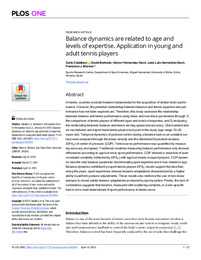Por favor, use este identificador para citar o enlazar este ítem:
https://hdl.handle.net/11000/34265Registro completo de metadatos
| Campo DC | Valor | Lengua/Idioma |
|---|---|---|
| dc.contributor.author | Caballero, Carla | - |
| dc.contributor.author | Moreno, Francisco Javier | - |
| dc.contributor.author | Barbado, David | - |
| dc.contributor.author | Hernández Davó, Héctor | - |
| dc.contributor.author | Moreno, Francisco Javier | - |
| dc.contributor.author | Hernández Davó, José Luis | - |
| dc.contributor.other | Departamentos de la UMH::Ciencias del Deporte | es_ES |
| dc.date.accessioned | 2025-01-10T09:30:54Z | - |
| dc.date.available | 2025-01-10T09:30:54Z | - |
| dc.date.created | 2021 | - |
| dc.identifier.citation | Plos One | es_ES |
| dc.identifier.uri | https://hdl.handle.net/11000/34265 | - |
| dc.description.abstract | In tennis, coaches consider balance fundamental for the acquisition of skilled motor performance. However, the potential relationship between balance and tennis expertise and performance has not been explored yet. Therefore, this study assessed the relationship between balance and tennis performance using linear and non-linear parameters through 1) the comparison of tennis players of different ages and levels of expertise, and 2) analyzing the relationship between balance and tennis serving speed and accuracy. One hundred and six recreational and expert male tennis players took part in the study (age range 10–35 years old). Temporal dynamics of postural control during a balance task on an unstable surface were analyzed through the mean velocity and the detrended fluctuation analysis (DFAV) of center of pressure (COP). Tennis serve performance was quantified by measuring accuracy and speed. Traditional variables measuring balance performance only showed differences according to age but not to sport performance. COP showed a reduction of autocorrelated variability (reflected by DFAV) with age but mainly in expert players. COP dynamics was the only balance parameter discriminating sport expertise and it was related to age. Balance dynamics exhibited by expert tennis players DFAV results support the idea that, along the years, sport experience induces balance adaptations characterized by a higher ability to perform postural adjustments. These results also reinforce the use of non-linear analysis to reveal subtle balance adaptations produced by sport practice. Finally, the lack of correlations suggests that balance, measured with scattering variables, in a non-specific task is not a main determinant of sport performance in tennis serve. | es_ES |
| dc.format | application/pdf | es_ES |
| dc.format.extent | 12 | es_ES |
| dc.language.iso | eng | es_ES |
| dc.publisher | PLOS | es_ES |
| dc.rights | info:eu-repo/semantics/openAccess | es_ES |
| dc.rights | Attribution-NonCommercial-NoDerivatives 4.0 Internacional | * |
| dc.rights.uri | http://creativecommons.org/licenses/by-nc-nd/4.0/ | * |
| dc.subject.other | CDU::7 - Bellas artes::79 - Diversiones. Espectáculos. Cine. Teatro. Danza. Juegos.Deportes | es_ES |
| dc.title | Balance dynamics are related to age and levels of expertise. Application in young and adult tennis players | es_ES |
| dc.type | info:eu-repo/semantics/article | es_ES |
| dc.relation.publisherversion | https://doi.org/10.1371/journal.pone.0249941 | es_ES |

Ver/Abrir:
2021_JCR_16_PlosOne_Balance dynamics are related to age and.pdf
779,79 kB
Adobe PDF
Compartir:
 La licencia se describe como: Atribución-NonComercial-NoDerivada 4.0 Internacional.
La licencia se describe como: Atribución-NonComercial-NoDerivada 4.0 Internacional.
.png)